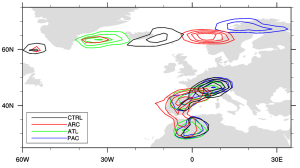A new ice2ice related paper studying the impacts of Arctic sea ice loss is being published in Journal of Climate (currently available as Early Online Release). The paper is authored by ice2ice researchers Rasmus A. Pedersen (NBI/DMI), Peter Langen (DMI) and Bo Vinther (NBI) in collaboration with Ivana Cvijanovic (LLNL, USA).
The analysis is based on general circulation model simulations with CESM in an idealized setup, and investigates the atmospheric response to sea ice loss in different parts of the Arctic.
Three investigated sea ice scenarios with ice loss in different regions all exhibit substantial near-surface warming which peaks over the area of ice loss. The maximum warming is found during winter, delayed compared to the maximum sea ice reduction. The wintertime response of the mid-latitude atmospheric circulation shows a non-uniform sensitivity to the location of sea ice reduction. While all three scenarios exhibit decreased zonal winds related to high-latitude geopotential height increases, the magnitudes and locations of the anomalies vary between the simulations.

Investigation of the North Atlantic Oscillation reveals a high sensitivity to the location of the ice loss. The northern center of action exhibits clear shifts in response to the different sea ice reductions. Sea ice loss in the Atlantic and Pacific sectors of the Arctic cause westward and eastward shifts, respectively.
The full paper is available at here.